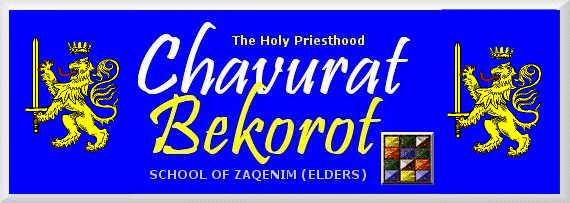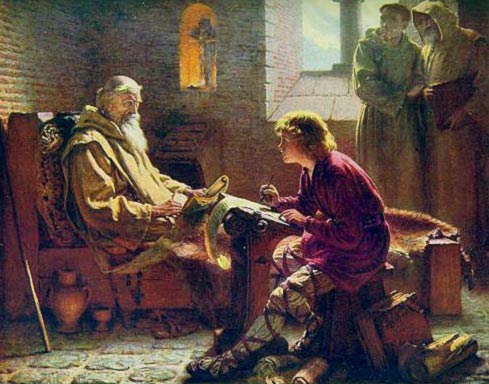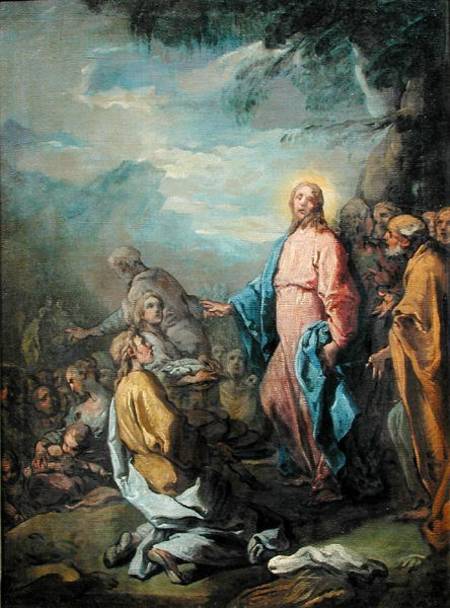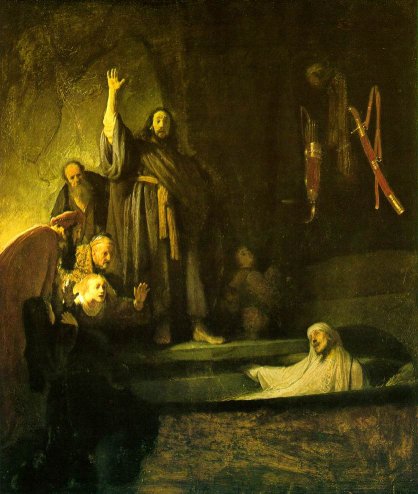
 15
JOHANNINE ESSAYS
15
JOHANNINE ESSAYS
 Two Signs Compared:
Two Signs Compared:
The Feeding of the Five Thousand
and Raising of Lazarus
(10 May 1983)
by Christopher C. Warren, M.A.(Oxon)

Intro | 1 | 2 | 3 | 4 | 5 | 6 | 7 | 8 | 9 | 10 | 11
12 | 13 | 14 | 15 | 16 | 17 | 18 | 19 | 20 | 21
The Greek word sémeion which is rendered "signs" has several shades of meaning, of which there are three principle ones: (1) A meaningful God-given token, indicating what Yahweh has done, is doing, or is about to do; (2) A miraculous authentication of a messenger from Yahweh -- the power to work miracles or produce authentic "signs" was expected in the ancient world from those who claimed to messengers God; and (3) An indication of the presence of Elohim (God) acting in grace or judgement. In my selection of two signs from John's Gospel we shall have the type #2 sign in mind.
I. Feeding the Five Thousand
This sign or miracle is especially important for several reasons but what strikes one immediately is the sheer scale of it. Not one but thousands partake of the miracle. The feeding takes place at the time of the Passover (Pesach) and this would suggest a connection with Moses and the manna, the death of Yah'shua (Jesus) (which took place at Passover/Pesach) and perhaps the institution of the Eucharist (Lord's Supper). John writes in a highly allegorical fashion and perceives in literal events deeper spiritual meanings. His second point is that the disciples can think of no way of dealing with the situation, and they themselves play no part in the miracle, apart from making the people sit down, and gathering up the remains. Thirdly, Yah'shua (Jesus) is completely in control of the situation: He knows what he will do, He ignores the remarks of His disciples, He gives them their instructions, and He alone distributes the food to the crowd. Fourthly, the people had followed Yah'shua (Jesus) because they had seen His cures, and now they were feeding as evidence that He is the prophet like Moses, and attempt to make Him king by force.

In the light of these four points. It might be true to say that John wishes his readers to see the feeding as a sign of the salvation which Yah'shua (Jesus) has brought to the world: He is the fulfilment of the ideas associated with the Passover (Pesach); He deals with a situation which to others seems impossible; He deals with it alone, but so adequately that there is no lack; and His action is misunderstood by those who have inadequate faith.
Yah'shua's (Jesus') use of certain elements is of interest too. The bread is obviously to be associated with the "bread of life" which is Yah'shua (Jesus) but notice too that John points out (where the Synoptists do not) that the bread was made of barley. In the East barley was one third of the value of wheat (Rev.6:6) and was regarded as poor man's food (Ezek.13:19). "Handfuls of barley" was an expression meaning "the meanest reward". Thus barley might rightfully be said to epitomise the self-denying doctrine of Christ. The leftovers were the property of the servitors in Jewish custom, or any residue after a meal. Hence the abundance of leftovers signifies the abundance of Yah'shua's (Jesus') salvation. The use of fish may have no symbolic significance though it should be pointed out that the sign of the fish was a common symbol of the early gentile believers because the letters of the Greek ICHTHYS (meaning 'fish') were taken as an acrostic for Iéosus Christos Theou Hyios Sótér, which meant, 'Jesus Christ, of God, the Son, Saviour' [1].
II. The Raising of Lazarus
The raising of Lazarus is the last miracle of Yah'shua (Jesus) which John records. He departs from his unusual practice of attaching dialogue to narrative and instead combines the two elements in such a way that it is now impossible to separate a basic story from the Johannine commentary written around it.
The interpretation which John gives directs the reader to a different understanding from simply being the climax of Yah'shua's (Jesus') miracles. It is not so much the power of Yah'shua (Jesus) displayed in calling a dead man to life that John puts before us, as the belief (faith, trust) which is symbolised by this miracle, namely, that the disciple is united with Christ in such a way that death cannot separate them. Or, as John puts it, that the believer "shall never die". This interpretation is given in the conversation between Yah'shua (Jesus) and Martha, and in the saying, "I am the resurrection". The raising of Lazarus is therefore not to be considered as if it were simply a wonder performed by Yah'shua (Jesus), but as a sign which shows that the result of faith is the eternal life of the believer in the present time: he need not wait for it until "the resurrection at the last day".

The significance of the sign does not depend on the historicity of the miracle; but it is fair to ask whether the story of the raising of Lazarus is historical. On the other hand, it is possible to point to stories of raising the dead in the Synoptic Gospels (e.g. Mk.5:23ff; Lk.7:11ff) and the saying "the dead are raised up" (Mt.11:5 = Lk.7:22), and to argue that John would not have recorded the story if he had not believed that it had happened, because his whole case is that the Word was made flesh and manifested His glory in historical events. On the other hand, it must be said that there is no room (as it were) for the raising of Lazarus in the Synoptic accounts, according to which the Judeans (Jews) take action against Yah'shua (Jesus) as a result of the cleansing of the Temple rather than the restoration of Lazarus.
III. A Comparison
The feeding of the 5,000 is one of the earlier miracles of Yah'shua (Jesus), the raising of Lazarus the very last. There is perhaps a progression in the order of the miracles and signs in the Fourth Gospel, from the first which involves material things (water to wine, multiplication of bread and fish), through sickness and lameness, hunger and blindness, to finally life for the dead (cp. 1 Cor.15:26, "The last enemy to be destroyed is death"). And further, the greater the revelation which Yah'shua (Jesus) gives, the greater the opposition to Him; so the last miracle finally provokes the Judeans (Jews) to put into effect their desire to destroy Yah'shua (Jesus) (Jn.11:45ff).
Thus the two miracles or signs represent different stages in the revelation of Yah'shua (Jesus) to the Judeans (Jews). In both, the power of Yahweh is manifested but with decidedly different results. Just as Pharaoh's magicians were able to reproduce the earliest of Moses' miracles, so contemporary charismatics were to some extent duplicating Christ's 'easier' miracles. But life over death was only within the reach of the Omnipotent Elohim (God) through His Messiah. In this respect Christ differed from the charismatic Hasidim, and once He stepped beyond the unwritten 'law' of these charismatic Judeans (Jews) he in effect challenged the Pharisaic structure and authority -- which may be why at this point (if the Johannine account is correct) the Judeans (Jews) sought to have Him killed.
 [1] This characteristic contemporary 'evangelical Christian' fish symbol with unclosed tail, is in fact, constructed of two crescent moons and was adopted by early Greek and Roman believers. It was borrowed directly from paganism. Ichthys was the name of a son of the ancient sea-goddess Atargatis, also known as Tirgata, Aphrodite, Derceto, Salacia, Pelagia, or Delphine, whose name meant both 'womb' and 'dolphin', and all appeared in mermaid form. Its assimilation into Christianity was ill-advised as the great goddess of Ephesus appeared with a fish amulet over her genitals, being a female-genital symbol. In Egypt, the fish that swallowed the male organ of Osiris was sometimes taken as a symbol of the female organ of Isis, who was yet another pagan incarnation of the primordial female deep. Again, the fish was constructed of two crescent moons, the conventional representation of paganism's high goddess, the demoness Hecate, the mythical source of all the earth's waters. Fish have therefore always been viewed by pagans as 'aphrodisiac' food because of their ancient association with the Aphrodite type of goddess and her sexual implications.
[1] This characteristic contemporary 'evangelical Christian' fish symbol with unclosed tail, is in fact, constructed of two crescent moons and was adopted by early Greek and Roman believers. It was borrowed directly from paganism. Ichthys was the name of a son of the ancient sea-goddess Atargatis, also known as Tirgata, Aphrodite, Derceto, Salacia, Pelagia, or Delphine, whose name meant both 'womb' and 'dolphin', and all appeared in mermaid form. Its assimilation into Christianity was ill-advised as the great goddess of Ephesus appeared with a fish amulet over her genitals, being a female-genital symbol. In Egypt, the fish that swallowed the male organ of Osiris was sometimes taken as a symbol of the female organ of Isis, who was yet another pagan incarnation of the primordial female deep. Again, the fish was constructed of two crescent moons, the conventional representation of paganism's high goddess, the demoness Hecate, the mythical source of all the earth's waters. Fish have therefore always been viewed by pagans as 'aphrodisiac' food because of their ancient association with the Aphrodite type of goddess and her sexual implications.
Also see A Question of Symbols and Magick.
Intro | 1 | 2 | 3 | 4 | 5 | 6 | 7 | 8 | 9 | 10 | 11
12 | 13 | 14 | 15 | 16 | 17 | 18 | 19 | 20 | 21


This page was created on 9 February 2004
Updated on 9 February 2004
Copyright © 1987-2008 NCCG - All Rights Reserved



